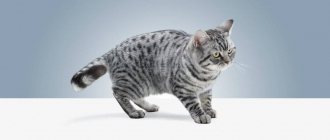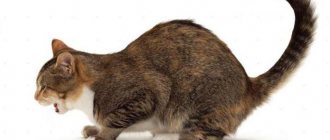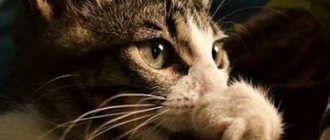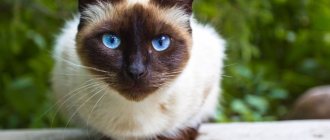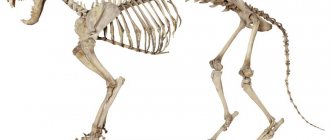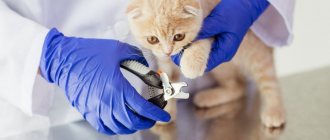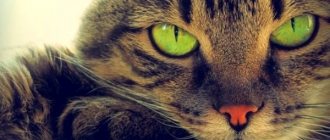What happens if a cat's whiskers are cut off: consequences
Many families with pets also have children who are often naughty. The antics of kids can be very unusual and varied. Often children decide to cut off the cat's whiskers. If you see that the kids are planning to do this, be sure to prevent them.
Consequences:
- The fact is that if a pet loses its whiskers, it will be quite poorly oriented in space. It may drift while walking. Particular difficulties are observed in the dark, as well as when a cat jumps onto some surface.
- The animal cannot navigate the distance to jump, as well as the size of the surface. After making several attempts, the cat can either crash into the cabinet, or break loose and fall. This provokes injuries to the pet’s limbs and head.
- In the dark, a cat is quite difficult to navigate without its whiskers. It can cut into the surface, which can also cause injury.
- Having lost its whiskers, the cat becomes helpless; this is equivalent to blindfolding a person and throwing him around the room. This is exactly how an animal feels without a mustache.
Cat without whiskers
Having performed so many important functions, it is no wonder that having lost them, such as if the whiskers of a cat were cut off as an experiment, the animal became completely inadequate.
If you shave off a cat's whiskers, It could bump into objects out of the blue (at night, it generally became completely disoriented in space). In addition, the sense of adequate perception of the world disappeared: often, if a cat’s whiskers were cut off, he could get stuck in a hole, unable to correctly “assess his size.” There were also ridiculous cases when a cat, walking straight, simply fell or, when jumping, did not reach the target (as it flew over).
We suggest you read: Where do domestic cats get fleas if they don’t go outside?
How will a cat that has lost its whiskers behave?
Under no circumstances should cats' whiskers be trimmed. As practice shows, cats with cut off whiskers begin to behave inappropriately - in much the same way as a person who is blindfolded. Animals deprived of vibrissae cannot decide on the size of the holes through which they have to crawl, and often get stuck in them.
Cats do not orient themselves in space, especially at night; walking and running become real torture for them, since they cannot move in a straight line. They cannot correctly calculate the distance in a jump, so stunts often end in limb injuries.
In addition, if previously animals perfectly saw objects standing in their way, then, deprived of whiskers, they will inevitably stumble upon them.
As you can see, the consequences of the loss of whiskers are very serious, so you need to carefully ensure that your pet does not lose them, for example, at the hands of naughty children. Very often, children, driven by curiosity, cut off the whiskers of four-legged pets without even suspecting what harm they cause them.
INTERESTING TO KNOW: How to properly wash a cat?
Kids need to be explained why they can’t trim their mustache, that it’s simply a mockery of a four-legged pet. Having lost the organ of touch, he will become completely defenseless against dangers. The animal, of course, will not die, but if its antennae are trimmed, it will experience great discomfort.
Functions of vibrissae
The purpose of the mustache is to be a kind of radar, an organ of touch. The longest, hardest and most sensitive ones are located above the upper lip, shorter and less sensitive ones are on the chin, under the eyes, all over the body, on the ankles, pads of the paws and even on the tail.
An adult cat has 12 hairs on each side of its cheeks. The average hair length is 6 centimeters. It is noteworthy that the cat's longest whiskers come from Finland. For this feature, it is even included in the Guinness Book of Records. The length of its whiskers is 19 cm.
The vibrissae give the cat the opportunity to explore the world around them and at the same time protect it from danger and are responsible for maintaining balance. It is thanks to their whiskers that cats are excellent hunters and can navigate in the dark without any problems. With their help, animals examine food for taste and freshness.
In addition, they are an indicator of mood - an angry cat tries to press the whiskers as close to the muzzle as possible, while in a good-natured animal the whiskers are directed forward. It is not surprising that many pet owners are concerned about this question: what will happen if a cat’s whiskers are cut off?
Why does a cat need a mustache?
In addition to good eyesight, a keen sense of smell and excellent hearing, nature has endowed representatives of the feline family with a specific organ - the whiskers. Whiskers or vibrissae in cats are coarse hairs that have a tactile function. Their bases, located in the superficial layers of the skin, are connected with a huge number of nerve endings. The impulse received from the whiskers is transmitted to special centers of the animal’s brain, where they are identified.
The slightest vibrational movements of air do not go unnoticed by the furry couch potato.
You can understand what will happen if you cut off a cat’s whiskers only if you have an idea of the diversity of their roles for animals. Zoologists note the following functions that they perform in domestic cats:
- Orientation in the surrounding space. Receiving reflective impulses from objects and walls, cats are well oriented even in unfamiliar surroundings. By analyzing changes in air flow, the animal receives information about the obstacle in its path.
This function is of no small importance when moving in the dark or hunting. When a pet ages and vision deteriorates, the whiskers help the elderly cat navigate and allow it to move without bumping into objects.
- The cat's whiskers also help when jumping. With their help, the distance to a particular object is determined, the trajectory and force of the jump are calculated. Vibrissae help furry fidgets make precise jumps over various distances, successfully hunt and avoid encounters with enemies.
- Being a kind of sensor of the vestibular apparatus, the vibrissae are involved in maintaining the balance of the animal when walking, jumping, and running.
- Whiskers are indispensable assistants in successful hunting of furry predators . The senses of touch help determine the direction and speed of the wind. With the help of its whiskers, the animal senses where the prey is moving in almost complete darkness.
- With the help of its whiskers, a cat can determine not only the distance, but also the depth of a particular hole . Having received reflective impulses from the walls, the animal can understand whether it will fit into this hole or not.
- Vibrissae help the cat determine the temperature of food and water and speed up the search for food resources.
- Zoologists believe that with the help of their whiskers, cats detect changes in the Earth's magnetic field and predict the weather with their further behavior.
- By carefully observing the pet, the owner can understand the cat's mood by the position of the whiskers. Widely spaced and slightly raised whiskers indicate that the animal is interested in something. If the cat is angry or afraid, the whiskers will most likely be pressed tightly to the face.
Knowing the various functions a cat's antennae perform, the owner wonders what will happen if a cat's whiskers are cut off, and whether this will affect his health and behavior.
Differences from animal hairs
There are physiological characteristics. The vibrissae are planted very deep into the skin; these are not ordinary hairs at all. Each whisker is an antenna that is surrounded by nerve cells. This is necessary to transmit signals directly to the brain center. But that is not all. Vibrissae are equipped with muscle fibers.
That is, it is not hair at all, but rather complex receptors. In fact, they are responsible for the sense of smell, they just changed during evolution. The longest and most sensitive mustaches are located on top, shorter ones can be seen in the chin area. Remember that cats hunt at night, they need to quickly and silently find and catch a rodent.
What and why
It’s not for nothing that even in fairy tales it was emphasized: mustachioed and striped. Gorgeous long whiskers are a source of pride for a cat, and often for its owners. Yes, nature gave them for a reason. Let's first look at why a cat needs a mustache. In addition to their decorative function, they are also an organ of smell. They even have a second name, which is rarely mentioned in everyday life.
Do whiskers break and why does a cat need whiskers?
The most harmless case is genetic predisposition. A cat's whiskers break on their own, for example, in sphinxes.
This is how short a mustache can be
Does your cat's whiskers sometimes become soft and brittle? This is a sure sign of a lack of vitamins - vitamin deficiency. It is worth reviewing your pet’s diet or changing food. It is also possible to add some special vitamins, which your veterinary clinic can help you choose. The most unpleasant thing that possibly happened to the cat was that he developed worms. In any case, the sign that cats’ whiskers are breaking does not pose a particular health hazard.
If a kitten’s whiskers break, you should worry a little more, because the baby is still a growing organism. All that can be done in this situation, like a kitten’s whiskers breaking, is to add more vitamins to the kitten’s menu: a spoonful of vegetable oil in the porridge, a little cottage cheese at night or a little milk in the morning. Or change the dry ration in favor of something more enriched with minerals and everything necessary.
Why cats' whiskers fall out and how dangerous it is
Some agree with the opinion that if a cat has lost its whiskers, they are unlikely to grow back and the animal will die.
The whiskers will grow back just as easily as the fur after another molt. But if a very rapid loss and long-term lack of growth of whiskers is noticed, then you should definitely show your pet to a veterinarian.
This could be a simple lack of vitamins, or something more serious, so it is better not to ignore this fact and seek help from a specialist.
If a cat's whiskers are temporarily absent, you should not let your pet outside, as during this period the animal is susceptible to disorientation.
This state can be compared to the sensations of a person who has lost his glasses. It is better to take care during this period and watch your pet at home, excluding any danger to her.
Interacting with your pet
A loving owner has at least once wondered what his cat is thinking about now, what his mood is. A mustache is a means of expressing facial expressions. If you know the decoding, you can easily understand your pet’s mood. Watch her and everything will become clear. If a fluffy beauty encounters an object that interests her, her whiskers stretch forward, as if studying it. Other movements convey a signal of alarm and danger. It is advisable to avoid such situations, so keep an eye on your pet. Thus, a cat's long whiskers are the key to your mutual understanding.
Does the cat not grow whiskers?
However, there are times when you should still worry. The cat's whiskers have fallen out, or the cat's whiskers are turning black, or new ones are not growing? Perhaps the whole reason is parasites or a lack of collagen or vitamin A. In addition, a worse option is possible, if your cat likes to walk, the whiskers may simply not “grow”, but are constantly lost in fights (cats often also bite off whiskers from to sweep).
And, probably, the last option is that the cat’s whiskers fall out if he is infected with a tick or lichen. The tick must be treated. And the deprivation must also be detected first: for this, the animal’s face must be illuminated with a special Voodoo lamp (the deprivation will glow an emerald color), or a scraping must be taken - in any case, you need to go to a veterinary clinic.
How to help an animal that has lost its whiskers
Regular whisker loss in cats without an identified cause requires additional examination by a veterinarian. After receiving the results, appropriate treatment methods can be carried out:
- taking anthelmintic and antiparasitic drugs for therapeutic and preventive purposes;
- antihistamines to eliminate allergies and antibiotics to treat infectious diseases;
- vitamins, minerals to strengthen and restore immunity.
Creating favorable living conditions for your pet:
- eliminating excessive dryness in the room when using a humidifier;
- ensuring that bathing is not too frequent and using special shampoos;
- the use of fatty acids (biotin, taurine) in compliance with the dosages prescribed by the veterinarian, since an excess amount of drugs can have the opposite effect;
- eliminating stress factors for your pet;
- use of high-quality animal feed;
- ensuring water balance (regular fluid intake by the cat throughout the day).
Recommendations for eliminating this problem if your cat’s whiskers fall out for various reasons:
- using cheap food for the animal, since such products are of poor quality and can negatively affect the general condition of the pet;
- regular treatment of the coat against parasites, fleas and ticks;
- processing raw meat to destroy helminth eggs that may be contained in it;
- excluding aggression towards the cat from other family members (young children);
- addition of various vitamin complexes to the daily diet of cats;
- regularly providing the required amount of drinking water for the animal, since its lack contributes to the development of urolithiasis and other problems;
- visit the veterinarian at least 2 times a year to assess the general condition of the pet;
- excluding the trimming of whiskers in cats, since even a slight shortening of the length can cause the development of negative consequences.
Whiskers for cats are one of the important organs that provide touch, so their damage becomes the cause of many disorders in the body. Vibrissae require careful care and control on the part of the pet owner to maintain the good condition of the animal.
Why hairs fall out
If it’s not just another change of coarse hairs, then why does a cat’s whiskers fall out is a question that inexperienced owners often ask online. Loss of whiskers occurs due to disorders in the animal’s body, so it is important to recognize the symptoms in time and take action
We suggest you read: How to teach a cat commands: give a paw, bring a toy, walk on its hind legs || We teach a cat to follow 8 commands - little secrets and tricks
Hypothyroidism usually occurs in older cats. This disease affects all body systems and leads to increased metabolism. In addition to the loss of the mustache, other signs are observed:
- wool properties deteriorate;
- the animal is hyperactive and noticeably nervous;
- appetite increases with weight loss;
- the pet experiences increased thirst, which it constantly strives to satisfy;
- sometimes diarrhea and vomiting occur.
The roots of the whiskers, compared to the roots of the fur, are located quite deep in the skin. They are surrounded on all sides by nerves, blood vessels and sensitive muscles. The development of a bacterial skin infection or the proliferation of parasites in the facial part of the head often explains why a cat's whiskers fall out. Such pathologies, accompanied by unbearable itching, are easily identified during an initial examination of the skin.
These disturbances in the hormonal system lead to changes in metabolism. Diabetes mellitus in middle-aged and elderly cats is usually indicated by such signs as increased thirst and frequent urination, excessive appetite against the background of general exhaustion of the body. The pet needs immediate help, otherwise the patient’s condition will worsen, and the loss of the antennae, compared to other problems, will no longer be noticeable.
The cat's body, like the human body, can react completely unexpectedly to some foods. Loss of whiskers and fur, accompanied by itching, redness of the mucous membranes, profuse salivation and discharge from the eyes - a condition caused by an allergic reaction.
Non-food allergies can be triggered by a variety of chemicals, certain types of plants and other objects that appear in a cat's environment. It is sometimes very difficult to determine what exactly caused the rebellion in the body; you have to use the method of elimination. The course of treatment will require the use of antihistamines.
When any illness appears, the metabolism in cats quickly makes itself known both in young and old age. The resulting pathologies manifest themselves as a rise in temperature, fluctuations in heart rate and other changes in the general condition.
In any case, you don’t need to think long about why your cat’s whiskers are falling out - a veterinary clinic specialist will explain in detail what to do in this situation.
How long are cat whiskers?
Now we know how many whiskers cats have, and now we know their length. As a rule, the length of hair formations in domestic felines is about 7 cm. But there are some exceptions, for example, the carriers of the longest antennae are individuals of the Maine Coon breed.
We suggest you read: Leukopenia in cats, symptoms and treatment: the cat has low leukocytes
But sphinxes have much shorter hair lengths, and their shape is slightly curled. It is not uncommon for representatives of this breed to experience a complete absence of antennae, and this is not at all associated with any disorders in the body.
The length of a cat's whiskers directly depends on his diet and breed. And people believe that the longer the whiskers, the more productive the cat is at catching mice. It is a known fact that the length of a hair is equal to the width of the body of a furry animal.
Approaching a narrow passage, the cat, having this information, tries on whether it can pass through this hole or not.
Cat whiskers and eyebrows or vibrissae (the scientific name for cat whiskers) presumably (since science itself does not yet know exactly why a cat needs them) perform as many as 3 functions:
- The first function of the whiskers is protective - you can check this yourself; a light touch on the cat’s eyebrows causes a blinking reflex in the cat, and on the whiskers - licking or pulling away.
- The second function of the whiskers is tactile; in a cat, such eyebrows and whiskers serve. In other words, your cat can, without using the organs of vision, but with the help of whiskers, receive information about objects that are even at dusk or in complete darkness. The cat analyzes not only the distance to such an object, but also receives the necessary information about the size and shape of the object itself.
- Well, the third function is that with the help of whiskers the animal evaluates the movements of air masses, because any movement, including human movements, is accompanied by the movement of air layers, and thanks to convection processes, odors, which are very important, move along with these air masses and layers for our cats.
Now, knowing about the functions of vibrissae, their scientific definition becomes clear to us. So, translated from Latin, this term means wriggling or oscillating, but zoology defines vibrissae as special tactile, mechanosensitive, hard, long hairs that protrude above the surface of the coat in many mammals.
So, for example,
Vibrissae are usually localized in groups - near the nose (we call them mustaches), near the eyes (eyebrows), in the jaw area ("beard"). And they can safely be classified as specialized sensory organs of cats that respond to the slightest changes in the environment.
But that's not all! Vibrissae are also a cat’s facial instrument, and depending on their position, we can even know exactly what our cat is feeling at the moment.
From all that has been said above, it becomes clear that the animal needs a cat’s whiskers and eyebrows not for decoration, but for specific functions. Accordingly, when the whiskers suffer (the cat singed them, or your baby decided to give her a new hairstyle), the cat not only changes in appearance, it is deprived of the opportunity to use one of its senses and facial expressions. You won't believe it, but
If the cat has lost its whiskers
Sometimes this is a necessary measure. For example, if surgery is required, the veterinarian will have to shave the fur together and whiskers to treat the entire area. This procedure is extremely painful for cats. This is another reason why cats should not have their whiskers trimmed.
The owners confirm that in this case the pet is literally replaced. His emotional background changes, the cat is in a bad mood. This is not surprising; her spatial orientation is impaired, and her brain is not yet accustomed to the changes.
Options for what will happen to a cat’s whiskers if they are cut: will they grow back?
The questions of what will happen if a cat’s whiskers are trimmed and how the pet will react to this are important for all owners of these pets. Veterinarians do not recommend getting rid of coarse hairs - some felines lose orientation in space for almost a month after such a procedure and can seriously harm themselves.
Will they grow back?
During scientific research, parts of the test animals had their whiskers removed completely or partially. Behavioral studies have shown that pets are more likely to get stuck in narrow holes, miss them, and be unable to get into them. Such failures had a bad effect on the psyche, the cats began to be afraid and hide, giving up any attempts.
You should not conduct your own experiments on a cat and trim its whiskers. It will take her a long time to grow them, and all household members will have to endure outbursts of aggression and other unpleasant reactions from a mentally unstable psyche.
Inappropriate behavior is the result of loss of vibrissae
Do cats grow whiskers?
Recovery will take some time. Their growth rate is three times faster than fur regrowth. Despite this, veterinarians warn that cutting the whiskers means losing the organs of vision.
Further care for the animal if its whiskers have been cut off
How to wash a cat: options if he is afraid of water and scratches
Do lost whiskers grow back in cats: even after trimming the hairs on the eyebrows and chin, they will be restored in 14-21 days. There are no special means to accelerate their growth - doctors advise using multivitamin complexes specifically designed for animals. They allow hairs to grow faster and become thicker.
Natural recovery will occur provided that no damage to the hair follicle occurred at the time of loss of the mustache. Animal care includes:
- protecting it from hot objects: fireplaces, gas and electric stoves, candles;
- using a special cap will help reduce the risk of head injuries;
- if a pet is placed in a cage for a while, then it will not be able to accidentally harm itself;
- an injured animal should not be allowed out into the street - there it can get under the wheels of a car, fall from a height, crash and damage not only its paws, but also its head.
Each new haircut of the whiskers will cause aggression in the pet towards its tormentor. If there are children in the house, then they immediately need to be explained why there are hard hairs on the cat’s body and what the risk of losing them is.
Trimming whiskers will not make a cat look beautiful; they play a big role in choosing a partner and communicating with familiar and unfamiliar relatives. Having lost their sixth sense organ, animals cannot hunt or move through previously unexplored places.
Nature has protected furry pets, but it will take a long time to recover from the loss, during which time they can suffer seriously.
Any stressful situation does not pass without a trace, then you should not be surprised at an animal that is aggressively opposed to its own owners.
Interesting facts about mustaches
- The system of pressure on the antennae can create a feeling of anxiety in them, so use a wide plate or flat feeder to eat.
- In addition to a dozen hairs that are located on different sides of the nose, there are rather short analogues that are located near the eyes, near the chin, and on the other side of the paws in front.
- The size of the hairs is such that they are literally similar to the width of the body, so they can figure out the width of the holes for themselves without even trying to pass through it.
- The placement of the mustache can be balanced by different moods. If they are completely relaxed and straightened in different directions, then the cat feels calm. If they are turned forward, it means there is anxiety.
- Without whiskers, cats may become disoriented and experience headaches, thereby not receiving vital signals.
Preventative measures to prevent mustache loss
When a cat's whiskers fall out, why this happened is the first thing that should interest the owner who loves his four-legged friend. He must do everything to prevent the loss of one of the main elements of the cat's body. Firstly, at the first manifestations of hair loss, you need to find out the cause and carry out the correct treatment. A veterinarian's examination and prescription will help with this. Preventive measures against vibris loss consist of the following:
- regular treatment of the animal for helminths and parasites;
- development of a suitable diet, including vitamins and microelements;
- eliminating possible allergens from the cat’s life;
- timely vaccination against diseases and infections;
- preventive visits to the veterinary clinic;
- keeping the animal and its habitat clean;
- carrying out hygiene procedures as necessary using suitable detergents;
- excluding self-medication.
Timely vaccination against diseases and infections
If you follow all the rules and make sure that the animal is not in conditions that are dangerous for it, you can minimize whisker loss. Remember that under no circumstances should a cat's whiskers be trimmed unless medically required. Also stop the habit of pulling your pet's whiskers, this causes him great discomfort.
Causes of acne on the chin of cats
There are actually no known causes for cat acne on the chin. But some possible factors include:
- Stress
- Poor care
- Dermatitis
- Bacterial overload (eating from dirty bowls)
- Impaired production of sebum (fatty substance)
- Contact hypersensitivity
- Suppressed immune system
- Concomitant infection or disease
Plastic cat food bowls were once considered a possible cause of acne in cats (allergic or contact hypersensitivity). With new research, it is believed that the real problem is the level of bacteria found in plastic utensils. Switching to glass, metal or ceramic cookware can help get rid of acne in some cases. I recommend stainless steel. But it is equally important to wash bowls frequently, at least once a day. If you are using plastic, use this tip first. If this is the reason, then improvements begin to be tracked after a week or a week and a half.
In addition to the above, think about raising food and water bowls. You should try to do this in such a way that the cat’s chin does not come into contact with the contents of the bowls.
Just like humans, cats develop acne due to allergies. You should change your cat's food and treats to make sure they don't contain the ingredient that is causing the allergic reaction. You would likely notice other allergic symptoms and signs if your cat had a food allergy or allergic contact dermatitis, but not always.
Diagnosis of acne and pimples in cats
Diagnosis of acne, as well as the diagnosis of acne in cats, should be carried out exclusively by a veterinary dermatologist. Only such a veterinarian is able to exclude other variants of dangerous diseases and problems, such as ticks, fungal and bacterial infections (primary or secondary), or fleas. Among other things, you need to accurately assess the cat’s general health and how much acne bothers her and how much discomfort it causes her. Research and diagnostic techniques include: skin scraping for microscopy, as well as culture to identify fungal spores and bacteria.
In severe cases where the skin is red and tender, a biopsy may be performed. This is necessary because acne can mimic other more serious diseases that should be ruled out first. It could be ringworm, skin mites, or even fungal yeast infections. All of this should be ruled out before any treatment is started.
Here are more photos of symptoms and signs of acne and pimples on the chin of cats
What disorders are associated with loss of mustache?
The sudden loss of a large number of mustaches is associated with the development of the following diseases:
- vitamin deficiency (lack of vitamin A, D and some microelements in the pet’s body);
- diseases of the thyroid gland (hypothyroidism, hyperthyroidism);
- diabetes;
- allergic reaction to food or certain substances;
- metabolic disease;
- skin diseases.
If a cat loses a significant number of its whiskers by the roots, it must be shown to a veterinarian. Self-medication will worsen your pet's condition.
The main causes of breakage and loss of whiskers in cats
Whiskers and eyebrows in cats contain keratin, so if they break or are constantly falling out, you should study the possible causes of this condition:
- the development of vitamin deficiency, since the lack of essential vitamins and ascorbic acid in the animal’s body leads to insufficient production of keratin, which strengthens the pet’s mustache;
- the appearance of allergic reactions, which may be accompanied by mustache loss;
- disruption of the endocrine system (diabetes mellitus, lack of hormones also cause characteristic signs of withdrawal and loss of whiskers);
- the presence of various dermatological diseases (ringworm, parasite infection, fungus, other pathologies);
- Lack of sufficient collagen in the daily diet also affects whisker growth in animals.
We invite you to familiarize yourself with Caniquantel for cats: instructions for use.
A distinctive feature of Sphynx cats is the presence of short mustaches with curls, so for them this length is considered the norm and should not arouse suspicion.
Most often, cats lose their whiskers when there are small children in the house who do not yet understand how serious animal twitching is. In such cases, you need to try to explain to the child that his actions are harmful to your beloved pet.
If the cat does not grow new whiskers, then he could damage the hair capsules, which contributed to normal growth and restoration of the whiskers. Therefore, consultation with a qualified veterinarian is required.
Symptoms of acne in cats on the chin
Many cats first develop a slightly dirty chin, covered in small black spots between the hair follicles. Sometimes, symptoms in cats are limited to just this manifestation. In other cases, it may begin to progress into swollen, red lumps that begin to rupture and bleed.
If the problem continues to progress, it is likely that the follicles may become infected with Staphylococcus aureus. This is a fairly common bacterial infection that can usually be found on the surface of the skin. This complication is called bacterial folliculitis. This serious skin infection requires more aggressive treatment. Folliculitis can also lead to secondary fungal infections if not treated properly.
